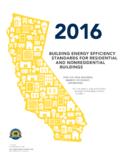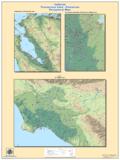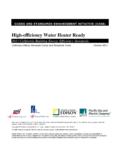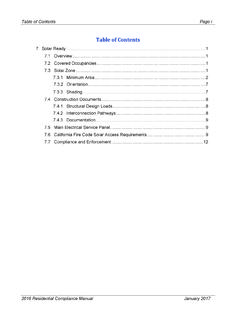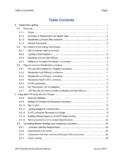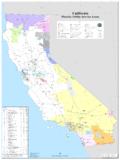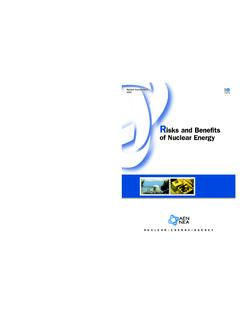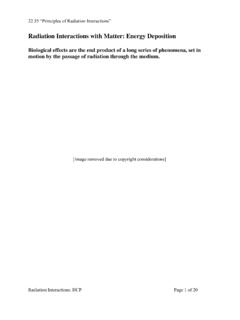Transcription of Nuclear Power Reactors in California
1 Page 1 of 8 Last updated March 2020 Nuclear Power Reactors in California As of mid-2012, California had one operating Nuclear Power plant, the Diablo Canyon Nuclear Power Plant near San Luis Obispo. Pacific Gas and Electric Company (PG&E) owns the Diablo Canyon Nuclear Power Plant, which consists of two units. Unit 1 is a 1,073 megawatt (MW) Pressurized Water Reactor (PWR) which began commercial operation in May 1985, while Unit 2 is a 1,087 MW PWR, which began commercial operation in March 1986. Diablo Canyon's operation license expires in 2024 and 2025 respectively. California currently hosts three commercial Nuclear Power facilities in various stages of Under all NRC operating licenses, once a Nuclear plant ceases reactor operations, it must be decommissioned.
2 Decommissioning is defined by federal regulation (10 CFR ) as the safe removal of a facility from service along with the reduction of residual radioactivity to a level that permits termination of the NRC operating license. In preparation for a plant s eventual decommissioning, all Nuclear plant owners must maintain trust funds while the plants are in operation to ensure sufficient amounts will be available to decommission their facilities and manage the spent Nuclear Spent fuel can either be reprocessed to recover usable uranium and plutonium, or it can be managed as a waste for long-term ultimate disposal. Since fuel re-processing is not commercially available in the United States, spent fuel is typically being held in temporary storage at reactor sites until a permanent long-term waste disposal option becomes In 1976, the state of California placed a moratorium on the construction and licensing of new Nuclear fission Reactors until the federal government implements a solution to radioactive waste disposal.
3 The Warren-Alquist Act is the legislation that created and gives statutory authority to the California energy commission . The Warren-Alquist Act sections and provide the specific language for the Nuclear fission reactor moratorium. Figure 1: Diablo Canyon Nuclear Power Plant 1 NRC webpage on the Decommissioning of Nuclear Facilities, 2 California Public Utilities commission webpage 3 NRC webpage on the storage of spent Nuclear fuel Page 2 of 8 Last updated March 2020 Source: Pacific Gas & Electric Diablo Canyon Photo Diablo Canyon Nuclear Power Plant4 has two Westinghouse-designed 4-loop pressurized-water Nuclear Reactors operated by Pacific Gas & Electric, the twin 1,100 MWe Reactors produce about 18,000 GWh of electricity annually.
4 The facilities once-through cooling system (OTC) draws water from the Pacific Ocean to condense steam that is then used to drive the turbine systems. On June 21, 2016, PG&E announced a Joint Proposal with some labor and environmental organizations to increase investment in energy efficiency, renewables and storage, while phasing out Nuclear Power . The proposal indicated that the operating licenses for Diablo Canyon Units 1 and 2 would not be renewed when they expire on November 2, 2024, and August 26, 2025, respectively. PG&E's application to close Diablo Canyon, including the Joint Proposal, was approved by the California Public Utilities commission in January 2018. In February, PG&E withdrew its application to the Nuclear Regulatory commission for a licensing extension.
5 Diablo Canyon Independent Safety Committee (DCISC) was established as a part of a settlement agreement entered into in June 1988 between the Division of Ratepayer 4 PG&E Diablo Canyon Power Plant website Page 3 of 8 Last updated March 2020 Advocates of the California Public Utilities commission (CPUC), the Attorney General for the State of California , and Pacific Gas and Electric Company (PG&E).5 Diablo Canyon Independent Peer Review Panel (IPRP) is comprised of technical experts from the California energy commission , California Geological Survey, California Coastal commission , California Seismic Safety commission , and the County of San Luis Obispo.
6 PG&E submits its seismic studies to the IPRP for review. Following the submission of these studies, the IPRP convenes for public meetings to review and discuss the results, and ultimately submits an IPRP Report. Figure 2: Humboldt Bay Nuclear Power Plant Source: Pacific Gas & Electric Humboldt Plant Photo Humboldt Bay Nuclear Power Plant6 was a 63 MW boiling water reactor, owned by Pacific Gas and Electric Company that operated from August 1963 to July 1976. It was the seventh licensed Nuclear plant in the United States. It was closed because the economics of a required seismic retrofit could not be justified following a moderate earthquake from a previously unknown fault just off the coast.
7 PG&E announced plans to permanently shutter the plant in 1983, and it was then placed in SAFSTOR inactive status in 1988. 5 Diablo Canyon Independent Safety Committee webpage 6 PG&E Humboldt Bay Power Plant website Page 4 of 8 Last updated March 2020 In 2004, Pacific Gas and Electric Company announced that three Nuclear fuel rods were unaccounted for due to conflicting records of their location. The fuel rods were never accounted for. In December 2008, PG&E finished moving the spent Nuclear fuel into dry cask storage on site. Decommissioning started in 2010. In 2012, PG&E concluded that complete removal of the reactor caisson, and containment by a cement slurry wall, is the only appropriate alternative to meet NRC standards for remediating C-14 contamination.
8 Based on PG&E s schedule of planned decommissioning activities, which incorporates various assumptions, including approval of its proposed new scope, decommissioning of the site is expected to conclude in 2019. Currently, used fuel rods are being stored in a below grade ISFSI 44 feet above sea level in containers with 22,000 pound lids. These containers are filled with Helium, and will remain onsite until moved by the Department of energy to a storage facility. According to the NRC ( Nuclear Regulatory commission ), the dry casks are safe for at least 60 years beyond their licensing agreement. Figure 3: San Onofre Nuclear Generating Station Source: Southern California Edison San Onofre Photo The San Onofre Nuclear Generating Station (SONGS) (Operated by majority owner Southern California Edison), about midway between Los Angeles and San Diego, went offline in January Page 5 of 8 Last updated March 2020 2012 and was ordered by the Nuclear Regulatory commission to stay offline while tubing wear issues were investigated.
9 Subsequently, plant owners announced in June 2013 that remaining Units 2 and 3 would be permanently retired. SONGS Unit 1 operated from 1968 to 1992. Unit 2 was started in 1983 and Unit 3 started in 1984 with retirement of both units announced June 2013. Unit 1 was a 456 MW pressurized water reactor. It was closed by its owners rather than incur $125 million in required modifications. Unit 2 & 3, two-loop pressurized water Reactors , generated 1,127 MWe gross, and 1,070 MWe and 1,080 MWe net respectively, when operating at 100%. Edison International, parent of SCE, holds ownership in the plant; San Diego Gas & Electric Company, 20%; and the City of Riverside Utilities Department, Unit 2 was shut down in early January 2012 for routine refueling and replacement of the reactor vessel head.
10 On January 31, 2012, Unit 3 suffered a radioactive leak largely inside the containment shell, with a release to the environment below allowable limits, and the reactor was shut down per standard procedure. On investigation, the replacement steam generators from 2011 in both units were found to show premature wear on over 3,000 tubes, in 15,000 places. In March 2012, the NRC forbade the plant to be reopened until the causes of its equipment problems were thoroughly understood and fixed. In August 2014, SCE announced decommissioning would take 20 years, cost $ billion and spent fuel would be held on-site in dry casks indefinitely. October 2015 the owners reached a $400 million settlement with their insurers for outages caused by the failure.
